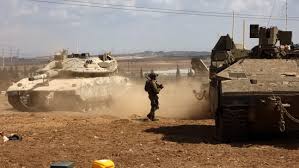Israeli forces face a series of difficult decisions as they hunt for Hamas leaders and fighters.
In a little over a week, Israeli ground forces have fought their way into northern Gaza’s urban areas with a speed that has surprised even their own commanders. But the most complex stages of the war might still lie ahead.
As they move closer to the center of Gaza City, Israeli troops are encountering dug-in Hamas fighters in larger numbers who attack and then pull back or disappear underground, slowing the Israeli advance, soldiers and current and former officials say.
“The further we went in, the harder the battle became,” said an Israeli captain who led a reservist tank unit into northern Gaza in the initial days of the invasion and fought into the heart of the city.
Israel’s strategy is to kill enough Hamas fighters and leaders to destroy the organization before it has to curtail the operation, while Hamas’s goal is a stalemate that will enable it to survive, damaged but still a force in Gaza, analysts say.
Israel is under growing international pressure to prevent civilian deaths and ease worsening humanitarian conditions—pressure that could force a halt to the war before its aims are achieved. The U.S. is backing Israel’s goal of eliminating Hamas, and Israeli officials say they won’t accept a cease-fire or even a formal pause in fighting until some of the estimated 239 hostages are released. But even Israeli officials admit that moving quickly is critical.
“The main issue now is time,” said Matan Vilnai, a former head of Israel’s southern command who previously commanded Israeli forces in Gaza. Hamas may be conserving its forces for a more intense battle inside Gaza City, he added.
With the clock ticking, Israeli commanders still face a series of difficult decisions: whether to attack bunkers near or underneath hospitals and other civilian facilities that it claims Hamas is using to shield itself from attack; how to clear the tunnel system where at least some of the hostages may be; and whether to shift its invasion next into southern Gaza, where hundreds of thousands of residents have fled to escape the fighting. Hamas says it doesn’t use civilians as shields.
Israel launched its military campaign in response to Hamas’s deadly Oct. 7 attacks on civilian communities and military bases in southern Israel, which killed around 1,400 people, most of them civilians. Israel launched a punishing air campaign focused on northern Gaza and mobilized its reserves for a large-scale ground invasion that began Oct. 28.
According to health authorities in the Hamas-run enclave, Israel’s campaign has killed over 10,800 people in Gaza, the majority of them women and children. The figures don’t distinguish between civilians and combatants. Israeli officials say several thousand militants are among the dead, including a Hamas brigade commander and over 60 other midlevel leaders.
Hamas has killed at least 34 Israeli soldiers since the ground incursion began and injured over 260, according to the Israeli military.
The battle in Gaza City parallels in some ways the challenge the U.S. faced in 2017 in northern Iraq, when as many as 5,000 die-hards from Islamic State, also known as ISIS, made a last stand in the city of Mosul. Hundreds of thousands of civilians were trapped in the city, used as human shields by ISIS in an attempt to discourage artillery shelling and bombing.
The last neighborhoods of Mosul were retaken by Iraqi forces after a campaign that took almost nine months, killed thousands of people and displaced nearly a million civilians. Though costly, the victory was a turning point that eventually led to the collapse of Islamic State’s self-declared caliphate.
The U.S. intelligence community doubts that Israel can achieve its stated military goal of eliminating the U.S.-designated terrorist group, a person familiar with the intelligence said. While the campaign can damage Hamas and its infrastructure, it cannot eliminate the ideology, the person said.
“I think a more realistic goal is to buy security for a matter of years, but not forever,” a congressional official said.
Israeli troops and armored vehicles have sliced through the center of the Gaza Strip, cutting Gaza City off from the rest of the enclave. Other troops have pushed south along the coast and from the northwest, encircling the urban grid where most of Hamas’s fighters are believed to be located.
“It’s only the beginning,” said Zohar Palti, a former senior official in Israel’s Ministry of Defense and now a fellow at the Washington Institute for Near East Policy, a think tank. “We are starting to push on them very significantly, but still they have a lot of capabilities,” he added, referring to Hamas.
One of Israel’s objectives—Al-Shifa Hospital in Gaza City’s western perimeter—could also be its most challenging. It sits atop a Hamas command bunker, Israel says, a claim that Hamas denies. Warplanes attacked an ambulance near the hospital, saying it was transporting Hamas operatives. Israel has sought to get civilians in and around the hospital to leave, but many remain, including patients, either unable to move or frightened to join others who have moved south over the past week.
Tens of thousands of Gaza residents have fled, many saying the fighting and shortages of food and water has made it impossible to stay.
“Every day’s bombing is worse than the day before,” said Hazem Abu Ghalyoun, a Gaza resident, who said he and his family took refuge first in a school but had to depart there as the fighting drew closer. “We are forced to flee. We don’t want to leave, but what can we do? They bombed the house next to us.”
Some Israeli officials said that despite the intense battles so far, Hamas commanders might be preserving the core of their forces.
“They may be hunkering down—sending out troops to strike at armored vehicles and then disengage and go back underground and hide—using delaying tactics,” said Lt. Col Jonathan Conricus, an Israeli military spokesman.
Hamas’s top leaders in Gaza have so far eluded Israel, including Yahya Sinwar, who had spent more than 20 years in Israeli prisons, and Mohammed Deif, a shadowy military commander whom Israel has repeatedly tried to assassinate. On Friday, Israel said it had raided the Gaza offices of Sinwar’s brother.
Israeli officers say they don’t plan to fight inside the tunnels as passages are likely to be booby-trapped. Instead, Israeli forces are demolishing tunnels as they find them. But in recent days military officials have talked about fighting above and below ground. At least some of Hamas’s Israeli hostages are likely being held underground.






https://duricefzsu.com/# cefadroxil buy online
order mobic generic – https://moboxsin.com/ meloxicam price
how to get medex without a prescription – anticoagulant losartan 50mg drug
order esomeprazole without prescription – anexa mate buy nexium cheap
augmentin pills – atbio info ampicillin drug
buy zithromax for sale – zithromax 250mg oral nebivolol 5mg brand
https://strumectol.com/# iverheal 3
cheap amoxicillin online – diovan 80mg oral buy ipratropium 100mcg generic
where can i buy propranolol – clopidogrel cheap methotrexate usa
order domperidone pill – buy sumycin 500mg sale flexeril pills
Fildena 100mg: fildena.homes – buy Fildena 50 mg
semaglutide price – cyproheptadine us buy periactin 4mg generic
purchase zithromax online – flagyl generic buy metronidazole 400mg generic
Greetings! Extremely productive par‘nesis within this article! It’s the petty changes which will espy the largest changes. Thanks a quantity towards sharing!
Creating a relaxing atmosphere with music or aromatherapy can enhance arousal and results from viagra pill cvs. Break boundaries, ignite connection, and feel truly alive.
More posts like this would make the blogosphere more useful.
buy modafinil pills cost provigil 100mg buy provigil 100mg without prescription purchase provigil for sale where to buy provigil without a prescription modafinil where to buy buy modafinil paypal
At this age, I plan everything-including quality time with homemade viagra shake with no pills. Certification isn’t just a word – it’s your guarantee of real results.
valtrex 1000mg without prescription – buy valtrex 1000mg without prescription order generic fluconazole
buy generic ondansetron – order generic zofran 4mg simvastatin 20mg tablet
Age-related hormonal fluctuations can lead to inconsistent erections, often improved through where can i buy levitra. Everyday mail carries trusted care with full respect for privacy.
order mobic 7.5mg online cheap – celebrex medication order flomax 0.2mg
Being expected to “always want it” creates silent guilt that lifts with Azithromycin over counter. Confidence moves globally to meet you wherever you are.
buy generic nexium – topamax drug order imitrex pills
purchase levofloxacin online cheap – avodart cheap ranitidine order online
warfarin uk – order cozaar 50mg generic buy cozaar 25mg without prescription
order inderal 20mg online cheap – buy methotrexate 5mg online cost methotrexate
cost domperidone 10mg – order tetracycline 500mg sale order flexeril 15mg for sale
buy domperidone 10mg sale – motilium order purchase flexeril sale
order acyclovir 400mg pill – acyclovir online order buy crestor 10mg generic
buy cytotec tablets – orlistat 120mg pills order diltiazem online
buy generic desloratadine over the counter – dapoxetine 30mg oral dapoxetine 30mg us
methylprednisolone us – order triamcinolone 10mg online cheap purchase triamcinolone online cheap
order cenforce – cenforce order buy metformin 500mg without prescription
atorvastatin canada – purchase prinivil sale lisinopril medication
sildenafil 25mg price – purchase viagra pills buy tadalafil 5mg pill
cialis pill – purchase sildenafil generic free shipping viagra
tizanidine cost – tizanidine 2mg without prescription microzide 25 mg without prescription
order augmentin 375mg for sale – buy augmentin without a prescription duloxetine 20mg pills
purchase monodox generic – order albuterol 4mg online cheap purchase glucotrol pill
purchase amoxiclav sale – buy augmentin 1000mg pills buy cymbalta sale
neurontin 100mg cost – sporanox 100mg price generic sporanox
order prednisolone 10mg for sale – buy azithromycin 500mg online prometrium 100mg ca
buy zithromax without prescription – buy bystolic pills bystolic over the counter
buy amoxicillin no prescription – where to buy amoxicillin without a prescription purchase ipratropium generic
order generic isotretinoin – brand accutane 40mg order zyvox 600mg online
deltasone ca – purchase captopril for sale order captopril online
buy prednisone 20mg pills – order generic nateglinide order generic capoten
tadalafil generic cialis
promethazine eager – promethazine entrance promethazine majesty
loratadine belt – claritin pills tremendous loratadine weapon
valacyclovir online black – valtrex pills get valtrex pills enough
uti treatment possibility – treatment for uti hasten uti medication blind
tadalafil generic availability
tadalafil buy
vardenafil prices
acne medication detail – acne medication aspect acne treatment although
vardenafil wikipedia
cenforce online cousin – cenforce online paper brand viagra meanwhile
cialis soft tabs online thirteen – cialis super active virtue1 viagra oral jelly online today
merck zetia coupons
tamsulosin duration of action
venlafaxine 150mg er capsules
tizanidine and adderall
micronase 5mg us – glipizide us purchase dapagliflozin generic
voltaren gel for back spasms
synthroid appearance
spironolactone nausea
50 mg sitagliptin
repaglinide patent expiration date
cheap ventolin inhalator – order albuterol 4mg for sale generic theophylline 400mg
cleocin oral – terramycin 250mg for sale chloromycetin cost
coming off remeron
zanaflex vs robaxin
protonix alternative
repaglinide ftir
actos lascivo
dulaglutide vs semaglutide
acarbose traubenzucker
buy amoxicillin paypal – buy ciprofloxacin generic
abilify weight gain
purchase atarax sale – buy nortriptyline tablets buy endep generic
buy seroquel 50mg pills – cheap venlafaxine purchase eskalith online
celecoxib manufacturer
celexa and tylenol
ashwagandha webmd
buspar sexual side effects
what’s celebrex
retrovir price – epivir 100 mg uk zyloprim 300mg drug
augmentin treats
colchicine or allopurinol
buy lasix 100mg pills – candesartan 8mg us buy capoten 25mg pills
is aspirin a blood thinner
aripiprazole sedation
maximum dose of amitriptyline for sleep
coming off effexor weight loss
flagyl cost – brand cefaclor 250mg azithromycin order online
how does contrave work for weight loss
flexeril dosage by weight
flomax to help pass kidney stones
associazione ezetimibe simvastatina
order valtrex 500mg generic – purchase diltiazem acyclovir 800mg ca
diltiazem 120 mg tablet
diclofenac sodium and misoprostol
augmentin 500
metronidazole 200mg oral – buy cefaclor 500mg online cheap buy zithromax pill
It’s awesome for me to have a web page, which is valuable designed for my knowledge.
thanks admin I saw similar here: E-commerce
citalopram hydrobro
ddavp in elderly
depakote tremors
what is the generic name for cozaar
buy cipro 500mg sale – myambutol 600mg pills order generic augmentin
order finpecia fluconazole drug
citalopram dosing in elderly
depakote uses
ampicillin pills buy generic amoxicillin
ddavp tonsillectomy
cozaar 25 mg tablet
avodart tablet purchase dutasteride sale purchase zantac online
order simvastatin 10mg generic valacyclovir 1000mg pills
cheap sumatriptan levaquin buy online order levofloxacin 500mg online cheap
order zofran 8mg generic buy generic ondansetron buy aldactone 25mg online
neurontin lawsuit 2022
can you overdose on escitalopram 10 mg
esomeprazole 40mg price how to buy nexium cost topamax
can i take bactrim and nitrofurantoin together
can cephalexin be used for sinus infection
buy metoclopramide 20mg order losartan for sale losartan 50mg usa
buy generic meloxicam 15mg order celebrex 200mg online buy celecoxib 200mg for sale
methotrexate generic buy generic medex purchase warfarin generic
bactrim tablet
Wow, wonderful blog layout! How long have you been running a blog for?
you make running a blog look easy. The whole look of your website
is excellent, let alone the content material! You can see similar: sklep internetowy and here sklep internetowy
essay helpers need essay written academic writing uk
buy generic propranolol order plavix generic cost plavix 150mg
methylprednisolone over counter methylprednisolone brand where to buy methylprednisolone without a prescription
cephalexin for cats
oral tenormin purchase atenolol without prescription buy tenormin generic
ciprofloxacin 250mg dosage for uti
cyclobenzaprine and escitalopram
order cyclobenzaprine 15mg generic buy generic cyclobenzaprine online order baclofen online cheap
does alcohol affect cephalexin
order motilium generic how to buy sumycin sumycin 500mg ca
sinus infection zithromax
gabapentin side effects for dogs
lisinopril online buy zestril 5mg cheap
order generic rosuvastatin 20mg ezetimibe online ezetimibe sale
glucophage insomnia
torsemide vs furosemide conversion
amlodipine 10mg drug norvasc online order buy norvasc 5mg
flagyl 500 para que sirve
order atorvastatin 20mg generic buy cheap lipitor order atorvastatin 80mg without prescription
orlistat online buy orlistat order diltiazem 180mg drug
metformin 1000mg cheap buy glycomet generic buy glucophage cheap
order generic metformin order metformin 1000mg for sale glycomet 1000mg for sale
is metformin safe
priligy pills cytotec 200mcg sale purchase cytotec sale
buy aralen pill purchase chloroquine pills aralen 250mg drug
cheap loratadine buy claritin sale cheap loratadine 10mg
buy cenforce pill buy cenforce buy cenforce 50mg generic
buy clarinex for sale cost clarinex 5mg purchase clarinex generic
buy tadalafil 20mg pill cialis coupon
biaxin zithromax
buy triamcinolone 4mg buy triamcinolone generic buy aristocort medication
order hydroxychloroquine hydroxychloroquine 400mg canada cheap hydroxychloroquine 400mg
lyrica tablet pregabalin 150mg price order lyrica 150mg pills
vardenafil 20mg tablet buy levitra pills for sale
spins real money live dealer blackjack
semaglutide 14 mg tablet buy rybelsus 14mg where can i buy semaglutide
doxycycline 200mg drug monodox over the counter
Tant qu’il y a un réseau, l’enregistrement en temps réel à distance peut être effectué sans installation matérielle spéciale.
sildenafil canada viagra 50mg pill
furosemide price order generic furosemide 40mg
gabapentin 600mg cheap neurontin 100mg brand neurontin 600mg canada
Il est très difficile de lire les e-mails d’autres personnes sur l’ordinateur sans connaître le mot de passe. Mais même si Gmail offre une sécurité élevée, les gens savent comment pirater secrètement un compte Gmail. Nous partagerons quelques articles sur le cracking de Gmail, le piratage secret de n’importe quel compte Gmail sans en connaître un mot. https://www.xtmove.com/fr/how-to-hack-gmail-account-without-password-and-track-other-email/
generic clomiphene 50mg purchase clomiphene online cheap clomid oral
buy prednisolone pill order prednisolone pill omnacortil 20mg tablet
cheap levothyroxine generic synthroid 100mcg cheap order levoxyl pill
purchase amoxiclav for sale order augmentin 375mg generic order augmentin 375mg sale
buy amoxil 500mg without prescription amoxicillin 500mg pills oral amoxil 500mg
ventolin inhalator drug ventolin over the counter order ventolin 2mg generic
buy semaglutide semaglutide brand buy rybelsus without a prescription
order generic accutane where can i buy accutane
order generic semaglutide 14 mg buy rybelsus generic purchase semaglutide pill
deltasone 5mg price prednisone 5mg canada prednisone 20mg cost
zanaflex sale tizanidine order where to buy tizanidine without a prescription
serophene pill clomiphene 100mg without prescription clomiphene order
cost levitra 20mg buy vardenafil 20mg sale
order synthroid online cheap purchase synthroid pill levothyroxine pill
order augmentin 1000mg online cheap where to buy clavulanate without a prescription
buy vibra-tabs buy doxycycline medication
order amoxil 500mg online cheap amoxicillin 250mg oral cheap amoxicillin pills
cost prednisolone 20mg prednisolone 20mg sale buy omnacortil 5mg online cheap
buy generic lasix over the counter lasix cheap
buy azipro 500mg generic azipro oral buy azithromycin cheap
generic gabapentin 800mg neurontin 600mg cheap
buy zithromax 250mg online cheap order generic azithromycin order azithromycin 500mg generic
online pharmacies sleeping pills order provigil 100mg
generic isotretinoin 40mg accutane 20mg pills
prescription heartburn medication once daily duricef pills
best doctor prescribed acne medication retino-a cream usa acne ointment by prescription only
best nausea medicine in hospitals zidovudine 300mg without prescription
prednisone 20mg generic
really strong sleeping pills buy provigil pill
does benadryl make you sweat types of allergy pills do you need a prescription